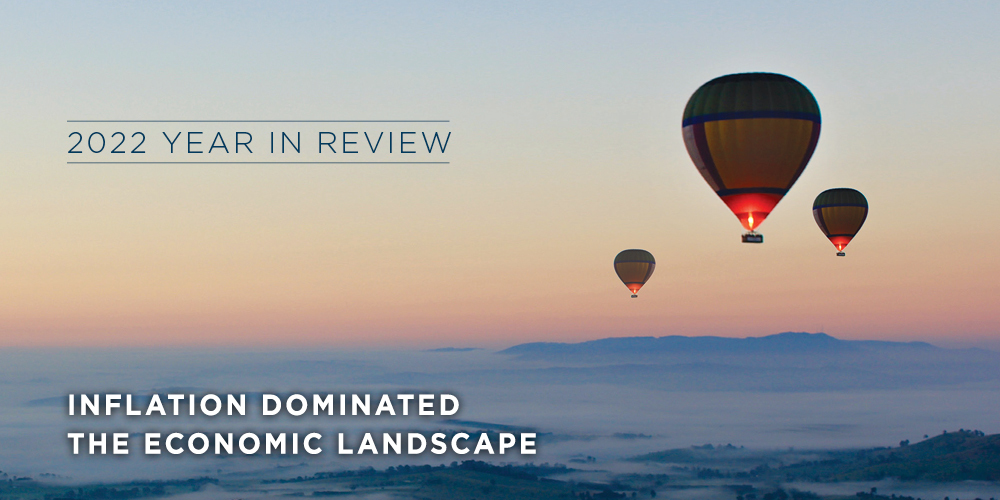
The year began on an optimistic note, as we finally began to emerge from Covid restrictions.
Then Russia threw a curve ball that reverberated around the world and suddenly people who had never given a thought to the Reserve Bank were waiting with bated breath for its monthly interest rate announcements.
2022 was the year of rising interest rates to combat surging inflation, war in Ukraine and recession fears. These factors combined to create cost-of-living pressures for households and a downturn in share and bond markets.
Super funds also suffered their first calendar year loss since 2011.
Ratings group Chant West estimates the median growth fund fell about 4% last year.(i)
While this is bad news for members, it’s worth remembering that super is a long-term investment, and that the median growth fund is still 11% above its pre-Covid high of January 2020.(ii)
| Australia key indices December | Share markets (% change) Year to December | ||||
| 2021 | 2022 | 2021 | 2022 | ||
| Economic growth | 4.6% | *5.9% | Australia All Ordinaries | 13.6% | -7.2% |
| RBA cash rate | 0.1% | 3.1% | US S&P 500 | 27.0% | -19.3% |
| Inflation (annual rate) | 3.5% | ^7.3% | Euro Stoxx 50 | 20.9% | -11.7% |
| Unemployment | 4.2% | #3.45% | Shanghai Composite | 4.8% | -15.1% |
| Consumer confidence | 104.3 | 82.5 | Japan Nikkei 225 | 4.9% | -10.9% |
*Year to September, ^September quarter # November
Sources: RBA, ABS, Westpac Melbourne Institute, Trading Economics
The Big Picture
Even though investors have come to expect unpredictable markets, nobody could have predicted what unfolded in 2022.
Russia’s invasion of Ukraine in February triggered a series of unfortunate events for the global economy and investment markets. It disrupted energy and food supplies, pushing up prices and inflation.
Inflation sits around 7 to 11% in most advanced countries, with Australia and the US at the low end of that range and the Euro area at the higher end.(iii)
As a result, central banks began aggressively lifting interest rates to dampen demand and prevent a price and wages spiral.
Rising Inflation and Interest Rates
The Reserve Bank of Australia (RBA) lifted rates eight times, taking the target cash rate from 0.1% in May to 3.1% in December.(iv)
This quickly flowed through to mortgage interest rates, putting a dampener on consumer sentiment.
Australia remains in a better position than most, with unemployment below 3.5% and wages growth of 3.1% running well behind inflation.(v)
Despite the geopolitical challenges, Australia’s economic growth increased to 5.9% in the September quarter(vi) before contracting to an estimated 3% by year’s end, in line with most of our trading partners.(vii)
Volatile Share Markets
Share investors endured a nail-biting year, as markets wrestled with rising interest rates, inflation, and the war in Ukraine.
Global shares plunged in October on interest rate and recession anxiety only to snap back late in the year on hopes that interest rates may be near their peak.
The US market led the way down, finishing 19% lower, due to its exposure to high-tech stocks and the Federal Reserve’s aggressive interest rate hikes.
Chinese shares (down 15%) also had a tough time as strict Covid lockdowns shut down much of its economy.
Australian shares performed well by comparison, down just 7%, thanks to strong commodity prices and the Reserve Bank’s relatively moderate interest rate hikes.
Energy and utilities stocks were strong due to the impact of the war in Ukraine on oil and gas prices.
On the flip side, the worst performers were information technology, real estate and consumer discretionary stocks as consumers reacted to cost-of-living pressures.
Property Slowdown
After peaking in May, national home values fell sharply as the Reserve Bank began ratcheting up interest rates. The CoreLogic home value index fell 5.3% in 2022, the first calendar year decline since the global financial crisis of 2008.
As always though, price movements were not uniform. Sydney (-12%), Melbourne (-8%) and prestige capital city properties generally led the downturn. Bucking the trend, prices continued to edge higher in Adelaide (up 10%), Perth (3.6%), Darwin (4.3%) and many regional areas.
Rental returns outpaced home prices, as high interest rates, demographic shifts and low vacancy rates pushed rents up 10.2% in 2022.
Gross yields recovered to pre-Covid levels, rising to 3.78% in December on a combination of strong rental growth and falling housing values. However, it’s likely net yields fell as mortgage repayments increased.
Despite the downturn, CoreLogic reports housing values generally remain above pre-COVID levels. At the end of December, capital cities combined were still 11.7% above their March 2020 levels, while regional markets were a massive 32.2% higher.
Looking Ahead
While the outlook for 2023 remains challenging, there are signs that inflation may have peaked and that central banks are nearing the end of their rate hikes.
Even so, the risk of recession is still high although less so in Australia where the RBA has been less aggressive in applying the interest rate brakes.
Issues for investors to watch out for in the year ahead are:
– A protracted conflict in Ukraine
– A new COVID wave in China which could further disrupt supply chains across the Australian economy, and
– Steeper than expected falls in Australian housing prices which could lead to forced sales and dampen consumer spending.
If you would like to discuss your investment strategy in the light of prevailing economic conditions, don’t hesitate to get in touch with us on 1300 78 55 77.
References
Note: all share market figures are live prices as at 31 December 2022 sourced from: https://tradingeconomics.com/stocks.
All property figures are sourced from: https://www.corelogic.com.au/news-research/news/2022/corelogic-home-value-index-australian-housing-values-down-5.3-over-2022
(i) https://www.chantwest.com.au/resources/another-strong-month-for-super-funds-as-recovery-continues/
(ii) As above
(iii) https://tradingeconomics.com/country-list/inflation-rate
(iv) https://www.rba.gov.au/statistics/cash-rate/
(v) https://www.rba.gov.au/snapshots/economy-indicators-snapshot/
(vii) https://www.rba.gov.au/publications/smp/2022/nov/economic-outlook.html





